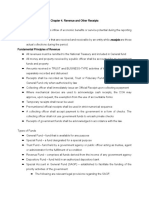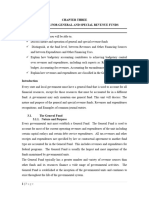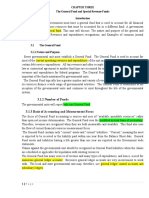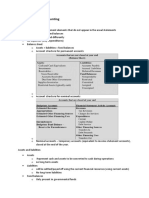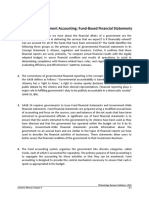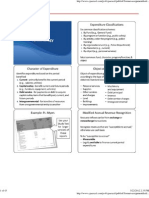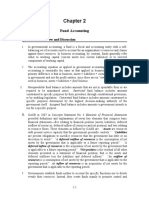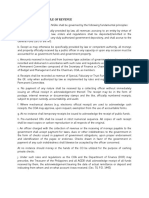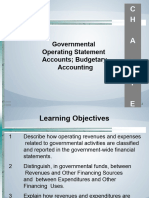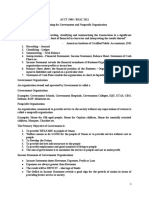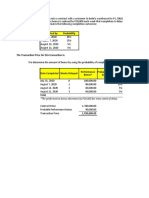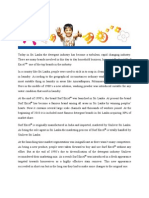Chapter 3
Revenue Accounting–Governmental Funds
Intergovernmental Revenue Accounting
GASB's guidance on non-exchange transactions establishes financial reporting
standards for intergovernmental grants and other financial assistance involving
financial resources, nonfinancial resources, or both.
Fund Identification
it is not always necessary to establish a separate fund for each grant, entitlement, or
shared revenue.
Operating grants restricted to a specific general government program or
activity usually are reported ire Special Revenue Funds.
Capital grants restricted for capital acquisitions or construction, other than
those associated with enterprise and internal service funds, should be
accounted for in a capital projects fund.
Entitlements االستحقاقات, or shared revenues received or utilized for enterprise
or internal service fund operations and/or capital assets should be accounted
for in those fund types. (Shared revenues—varies in amount in each period
(depending on collections) and allocated based on some formula)
Pass-Through Grants
The primary recipient, such as a state government, receives the grant—say, from the
federal government to support special education programs.
The primary recipient cannot spend the resources for its own purposes but must
"pass through" the resources to a secondary recipient—say, a local government or
public school district— which is referred to as the sub-recipient.
Note that
All cash pass-through grants received by a governmental entity (referred to as a
recipient government) should be reported in its financial statements.
In those infrequent cases in which a recipient government serves only as a cash
conduit, the grant should be reported in an agency fund.
Revenue Recognition
Revenues [earned or levied] from non-exchange transactions should be recognized
"in the accounting period when they become available and measurable."
Revenue resulting from government-mandated non-exchange transactions [grants] and
voluntary non-exchange transactions [grants] should be recognized in the period when all
applicable eligibility requirements have been met and the resources are available.
Grant Received Before Earned
Cash $100,500
Unearned revenues $100,500
To record receipt of grant, entitlement, or
shared revenue prior to revenue being
earned and recognized
0
�When the conditions of the grant, entitlement, or shared revenue restrictions have been met
Expenditures $40,000
Vouchers payable $40,000
Unearned revenues $40,000
Revenues $40,000
Grant Earned Before Received
Expenditures $40,000
Vouchers payable $40,000
Due from grantor $40,000
Revenues $40,000
If the reimbursement grant pays more or less than the direct expenditures
incurred, the amount reimbursed is recorded as the grant receivable and revenue.
If the grant receivable is not expected to be collected soon enough for the related
revenue to be considered available, Deferred Revenues (not Revenues) is credited
initially and reported as deferred inflows on the balance sheet
Charges For Services
Revenues from charges for services consist of charges made by various general
government departments for goods or services rendered by them to the public, other
departments of the government, or other governments. Similarly, special assessments
for current services are considered departmental charges for services revenues.
Due from other governmental units 25000
Revenues 25000
Account receivable 20000
Revenues 20000
Cash 38200
Revenues 38200
1
� Fines and Forfeits
Revenues from fines and forfeits are not usually an important source of a government's
income. Because they are not often susceptible to accrual prior to collection, these
revenues are usually accounted for on d cash basis, particularly by local governments.
Fines and other penalties included in this section are primarily those
imposed by the courts.
The money from cash bonds and bail is often first accounted for in an Agency Fund. If
forfeited, it must be disbursed as specified in applicable laws. Unless the law provides
otherwise, forfeited bail money is paid from the Agency Fund to the General Fund,
where it is recorded:
Cash $5,000
Revenues $5,000
Investment Earnings
Short-term investment of cash available in excess of current needs is authorized
by legislative bodies throughout the country.
GASB Statement No. 31 establishes fair value standards for investments in:
a) Participating interest-earning investment contracts.
b) External investment pools,
c) Open-end mutual funds.
d) Debt securities.
e) Equity securities, option contracts, stock warrants, and stock rights
that have readily determinable fair values.
GASB Statement No. 31 requires that:
1- Governmental entities report many types of investments at fair value in the
balance sheet.
2- All investment income, including changes in the fair value of investments,
usually should be reported as revenue in the operating statements.
Statement No. 31 permits governmental units to continue reporting certain investments at
amortized cost, including lower of amortized cost or fair value, rather than at fair value.
These exempted investments include:
Non-participating interest-earning investment contracts.
Money market investments and participating interest earning investment
contracts that have a remaining maturity when purchased of one year or less
Example: A Governmental Unit made two, 2-year $500,000 investments on July 1, 20X1, the
beginning of its fiscal year, in 6% interest-earning contracts. Each investment was
purchased at a discount of $4,000. The fair value of each investment at June 30,20X2,
was $497,000.
1- One investment, Investment A, will be accounted for on the amortized cost method.
2- The other investment, Investment B, is to be accounted for on the fair value method.
2
� Investment A Investment B
Investments $496,000 Investments $496,000
Cash $496,000 Cash $496,000
Cash $30,000 Cash $30,000
Revenues – interest $30,000 Revenues – interest $30,000
Investments $2,000
Revenues – interest $2,000
Investments $1,000
Revenues – increase F.V $1,000
Aslan County purchased $3,000,000 of bonds as a General Fund Investment on Marc 1, 20x17,
for $3,060,000 plus four months accrued interest of $80,000. The bonds mature in four
years and two months.
1. The county received the semi-annual interest payment on the bonds ($120,000) on
April 30, 20x7.
2. The county received the October 31 semi-annual interest payment ($120,000).
3. On December 31, the end of Aslan’s fiscal year, the fair value of its bond
investment was $3,065,000 (excluding accrued interest).
Required
(a) Record these transactions in General Ledger accounts of the Aslan County General Fund.
1 March Investments 3060000
Accrued Interest Receivable 80000
Cash 3140000
30 April Cash 120000
Accrued Interest Receivable 80000
Interest revenues 40000
31 Oct. Cash 120000
Interest revenue 120000
31 Dec. Interest receivable 40000
Interest revenue 40000
Investment 5000
Revenues increase in fair value 5000






